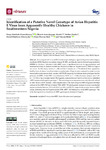2021-04-26Zeitschriftenartikel
Identification of a Putative Novel Genotype of Avian Hepatitis E Virus from Apparently Healthy Chickens in Southwestern Nigeria
Osamudiamen, Fisayo Temilade
Akanbi, Olusola Aanuoluwapo
Zander, Steffen
Oluwayelu, Daniel Oladimeji
Bock, Claus-Thomas
Klink, Patrycja
Avian hepatitis E virus (aHEV) is the major etiological agent of hepatitis-splenomegaly syndrome (HSS), big liver and spleen disease (BLSD), and hepatic rupture hemorrhage syndrome (HRHS) in chickens. Infections with aHEV cause a significant decrease in egg production and increased mortality in chickens worldwide. However, studies on the prevalence of aHEV in Nigeria are scarce. In this study, serum (n = 88) and fecal samples (n = 110) obtained from apparently healthy layer chickens from three states in southwestern Nigeria were analyzed by nested reverse transcription-polymerase chain reaction (nRT-PCR) targeting the helicase and capsid gene for the presence of aHEV. Avian HEV was detected in 12.5% (n = 11/88) of serum samples and 9.1% (n = 10/110) of fecal samples tested. Phylogenetic analysis showed that five of the twelve identified aHEV sequences belonged to genotype 2. The remaining seven sequences were only distantly related to other known aHEV isolates. After amplification of the near-complete ORF2 fragment (1618 bp) and part of the ORF1 (582 bp) of isolate YF40_aHEV_NG phylogenetic analysis revealed a nucleotide sequence identity between 79.0 and 82.6% and 80.1 and 83.5%, respectively, to other known aHEV strains, indicating that the Nigerian isolate YF40_aHEV_NG belongs to a novel aHEV genotype. This is the first report of co-circulation of aHEV genotypes in chickens in Nigeria.
Files in this item

